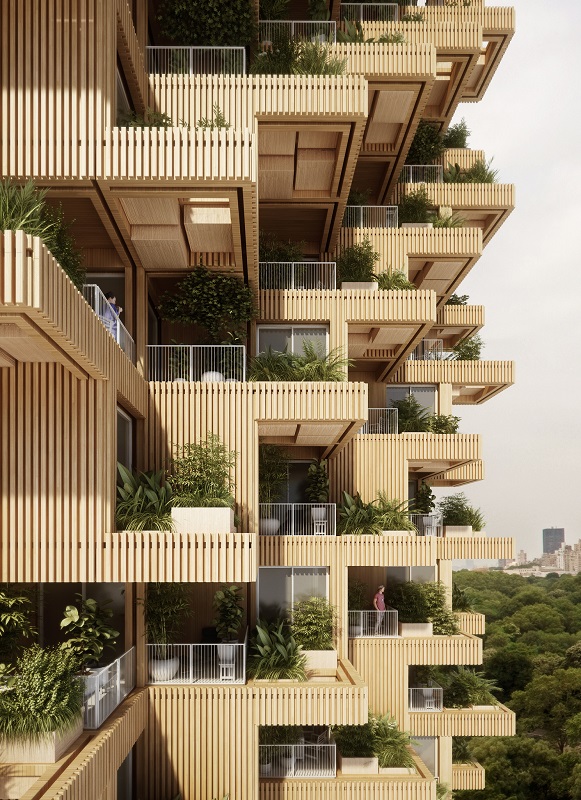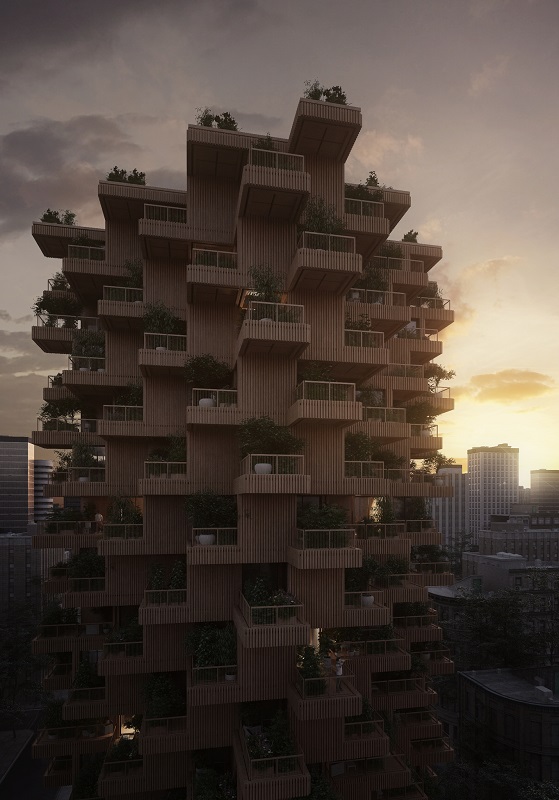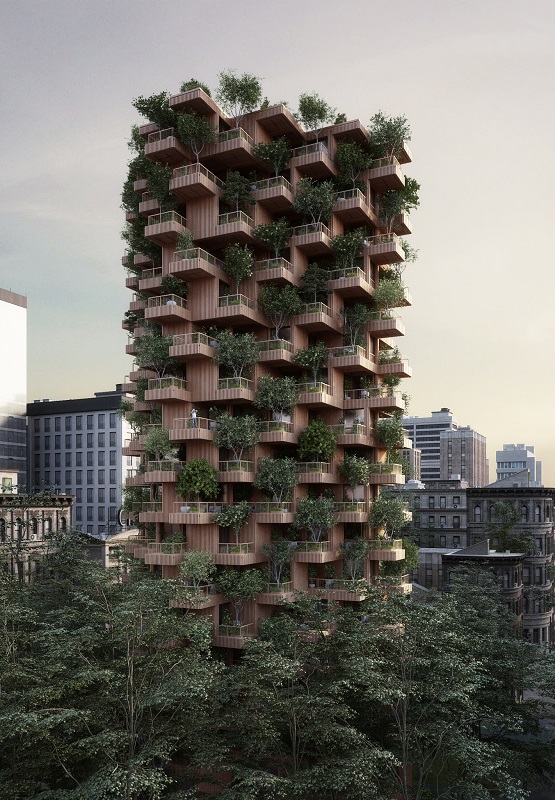Toronto Tree Tower
In 2017, Penda architects teamed up with the Canadian timber consultants Tmber to design a modular high-rise tower for Toronto.
The Toronto Tree Tower is intended to be a catalyst for future residential buildings that are more efficient to construct and more ecological than some more common construction methods. The 18-storey tower will stand 62 m high and will provide 4,500 sq. m of residential space and 550 sq. m of public space.
Canada has a long tradition of timber construction and was one of the first countries in the world to change their building codes to use timber in vertical structures. It was also a forerunner for a modular, prefabricated construction which was both efficient and visually interesting, a primary example being Moshe Safdie’s Habitat 67.
Inspired by the Habitat, The Tree Tower proposes using pre-fabricated and pre-cut cross-laminated timber (CLT) panels, assembled into modules off-site at an indoor facility.
The modular, prefab process is faster, less noisy, reduces waste and allows a high degree of quality control as most parts of the building are assembled in a controlled indoor environment. The structure of the building is mainly massive timber panels with a hybrid of CLT, concrete and steel-elements where needed and makes a statement about the use of engineered wood products in vertical structures. The tower not only uses massive timber panels as its main structural elements, but also has timber-clad panels on its facade.
Large outdoor areas provide a space for herb and vegetable planters for the residents. The botany on the terraces offer a private garden for each apartment, which creates a degree of privacy within the density of the city. The trees also provide shade in the summer and help to keep the temperature low on warm days.
Content and images courtesy of Penda.
[edit] Find out more
[edit] Related articles on Designing Buildings Wiki
Featured articles and news
RTPI leader to become new CIOB Chief Executive Officer
Dr Victoria Hills MRTPI, FICE to take over after Caroline Gumble’s departure.
Social and affordable housing, a long term plan for delivery
The “Delivering a Decade of Renewal for Social and Affordable Housing” strategy sets out future path.
A change to adoptive architecture
Effects of global weather warming on architectural detailing, material choice and human interaction.
The proposed publicly owned and backed subsidiary of Homes England, to facilitate new homes.
How big is the problem and what can we do to mitigate the effects?
Overheating guidance and tools for building designers
A number of cool guides to help with the heat.
The UK's Modern Industrial Strategy: A 10 year plan
Previous consultation criticism, current key elements and general support with some persisting reservations.
Building Safety Regulator reforms
New roles, new staff and a new fast track service pave the way for a single construction regulator.
Architectural Technologist CPDs and Communications
CIAT CPD… and how you can do it!
Cooling centres and cool spaces
Managing extreme heat in cities by directing the public to places for heat stress relief and water sources.
Winter gardens: A brief history and warm variations
Extending the season with glass in different forms and terms.
Restoring Great Yarmouth's Winter Gardens
Transforming one of the least sustainable constructions imaginable.
Construction Skills Mission Board launch sector drive
Newly formed government and industry collaboration set strategy for recruiting an additional 100,000 construction workers a year.
New Architects Code comes into effect in September 2025
ARB Architects Code of Conduct and Practice available with ongoing consultation regarding guidance.
Welsh Skills Body (Medr) launches ambitious plan
The new skills body brings together funding and regulation of tertiary education and research for the devolved nation.
Paul Gandy FCIOB announced as next CIOB President
Former Tilbury Douglas CEO takes helm.
UK Infrastructure: A 10 Year Strategy. In brief with reactions
With the National Infrastructure and Service Transformation Authority (NISTA).


























Comments
Can we have comments on actual living conditions encountered by residents compared to their previous living?